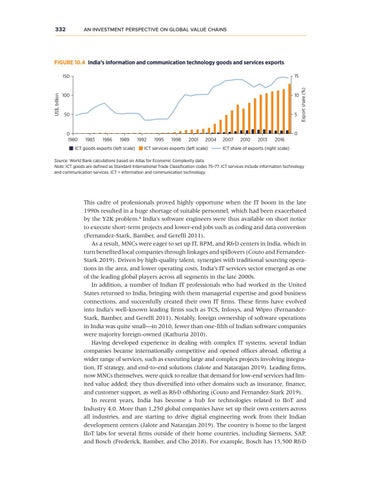AN INVESTMENT PERSPECTIVE ON GLOBAL VALUE CHAINS
332
150
15
100
10
50
5
0 1980
Export share (%)
US$, billion
FIGURE 10.4 India’s information and communication technology goods and services exports
0 1983
1986
1989
ICT goods exports (left scale)
1992
1995
1998
2001
2004
ICT services exports (left scale)
2007
2010
2013
2016
ICT share of exports (right scale)
Source: World Bank calculations based on Atlas for Economic Complexity data. Note: ICT goods are defined as Standard International Trade Classification codes 75–77. ICT services include information technology and communication services. ICT = information and communication technology.
This cadre of professionals proved highly opportune when the IT boom in the late 1990s resulted in a huge shortage of suitable personnel, which had been exacerbated by the Y2K problem.4 India’s software engineers were thus available on short notice to execute short-term projects and lower-end jobs such as coding and data conversion (Fernandez-Stark, Bamber, and Gereffi 2011). As a result, MNCs were eager to set up IT, BPM, and R&D centers in India, which in turn benefited local companies through linkages and spillovers (Couto and FernandezStark 2019). Driven by high-quality talent, synergies with traditional sourcing operations in the area, and lower operating costs, India’s IT services sector emerged as one of the leading global players across all segments in the late 2000s. In addition, a number of Indian IT professionals who had worked in the United States returned to India, bringing with them managerial expertise and good business connections, and successfully created their own IT firms. These firms have evolved into India’s well-known leading firms such as TCS, Infosys, and Wipro (FernandezStark, Bamber, and Gereffi 2011). Notably, foreign ownership of software operations in India was quite small—in 2010, fewer than one-fifth of Indian software companies were majority foreign-owned (Kathuria 2010). Having developed experience in dealing with complex IT systems, several Indian companies became internationally competitive and opened offices abroad, offering a wider range of services, such as executing large and complex projects involving integration, IT strategy, and end-to-end solutions (Jalote and Natarajan 2019). Leading firms, now MNCs themselves, were quick to realize that demand for low-end services had limited value added; they thus diversified into other domains such as insurance, finance, and customer support, as well as R&D offshoring (Couto and Fernandez-Stark 2019). In recent years, India has become a hub for technologies related to IIoT and Industry 4.0. More than 1,250 global companies have set up their own centers across all industries, and are starting to drive digital engineering work from their Indian development centers (Jalote and Natarajan 2019). The country is home to the largest IIoT labs for several firms outside of their home countries, including Siemens, SAP, and Bosch (Frederick, Bamber, and Cho 2018). For example, Bosch has 15,500 R&D










